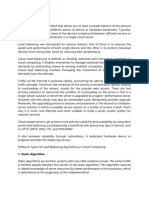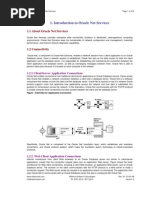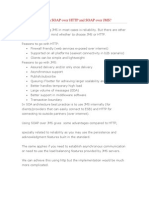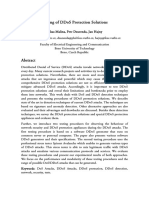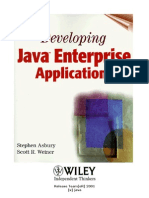Load Balancing Techniques For Release 11I and Release 12 E-Business Environments
Load Balancing Techniques For Release 11I and Release 12 E-Business Environments
Uploaded by
rramsCopyright:
Available Formats
Load Balancing Techniques For Release 11I and Release 12 E-Business Environments
Load Balancing Techniques For Release 11I and Release 12 E-Business Environments
Uploaded by
rramsOriginal Title
Copyright
Available Formats
Share this document
Did you find this document useful?
Is this content inappropriate?
Copyright:
Available Formats
Load Balancing Techniques For Release 11I and Release 12 E-Business Environments
Load Balancing Techniques For Release 11I and Release 12 E-Business Environments
Uploaded by
rramsCopyright:
Available Formats
LOAD BALANCING TECHNIQUES FOR RELEASE 11i AND RELEASE
12 E-BUSINESS ENVIRONMENTS
Venkat Perumal
IT Convergence
Introduction
Any application server based on a certain CPU, memory and other configurations has a limit. Once the server
reaches its capacity, performance is impacted. In order to provide better performance, a server can be replaced by a
more efficient server to handle the load. A better option is to implement cost effective solutions such as load
balancing to share the load with additional servers of similar configurations. Load balancing can be achieved based
on response time, least connections, least bandwidth or response time. The load can be balanced at different levels
such as server, network or operating system. One of the primary goals of load balancing is to distribute the load
among many servers, so that the overall throughput of the system is improved.
The purpose of this paper is to explore Oracle’s E-Business suite 11i load balancing options. Although there are
number of ways to achieve load balancing, this paper explores five primary load balancing techniques associated
with this application.
The five load balancing techniques are:
1. Domain Name Server Load Balancing
2. HTTP Server Load Balancing
3. Forms Metric Load Balancing
4. Apache Jserv Load Balancing
5. Parallel Concurrent Processing (PCP) Load Balancing
The first four techniques are associated with middle tier, and Parallel Concurrent Processing (PCP) focuses on
concurrent manager tier.
Domain Name Server Load Balancing
As the name indicates a Domain Name Server (DNS) is utilized to load balance Oracle’s E-Business suite 11i
applications. Domain Name Server translates a domain name into an IP address. In this technique, single domain
name is mapped tot multiple IP addresses of web servers. This technique is widely used to load balance web servers
and is used by web services including Google and Yahoo.
Depending upon the number of users, the technique used in DNS load balancing varies. For an 11i application
environment, a DNS technique called Round Robin Domain Name Service (RRDNS) is widely used, where the user
requests are forwarded on a cyclical fashion.
As shown in Diagram 1, when a user requests the URL, DNS first translates the domain name to IP address and
routes back the request to webnode1, the second user request onto webnode2 and the third user request onto
webnode3, and thus in a cyclical fashion the user load is balanced among the web servers. This is quite inexpensive
and easy to setup.
Oracle’s E-Business suite 11i applications’ URL is based on hostname and domain name, for example
http://itcerp.itconvergence.com, where itcerp is the hostname where the web server is installed. Since there is more
than one web server involved and the URL remains static for all users, the virtual host naming technique is used to
map the different web servers to an assigned virtual host. A virtual host name is mapped to multiple IP addresses in
such a way that when the URL is accessed, it is translated and the request is passed on to the particular web server.
COLLABORATE 08 Copyright ©2008 by Venkat Perumal Page 1
DNSDNS Mapping
Mapping
http://apps.itc.com …..192.168.100.10
http://apps.itc.com …..192.168.100.10
http://apps.itc.com …..192.168.100.11
http://apps.itc.com ….. 192.168.100.11
http://apps.itc.com …..192.168.100.12
http://apps.itc.com ….. 192.168.100.12
Diagram 1: Domain Name Server Load Balancing – Architecture
DNS Load Balancing Configuration
This configuration does not require additional patches, but virtual host name and DNS configuration are required.
The following autoconfig parameters should be configured with virtual host name:
1. S_LOGIN_URL
2. FORMS60_MAPPING
3. PROXY SERVER
4. WEBSERVER ENTRY
Scenario
Medium range business clients with 300 to 500 concurrent users would be ideal for DNS load balancing. In most
cases the web server and forms server will be installed on the same host, and DNS load balancing can be used to
load balance both self-service and forms requests.
Advantages and Disadvantages of DNS
1. DNS load balancing technique is primarily used to load balance multiple web servers.
2. High availability and failover is not guaranteed.
3. Does not consider “actual” server load - balances number of users on each server, it does not necessarily balance
the server load.
4. In the event of server failure, DNS needs to be reconfigured. This may be a bigger problem when removing a
node then when adding one. When a node is dropped, a user may be trying to access a non-existing server.
HTTP Server Load Balancing
In HTTP server load balancing, an HTTP load balancer is used to redirect requests onto multiple web servers. As
shown in Diagram 2, there are two web nodes. When a user request arrives the HTTP load balancer redirects the
requests to one of the least loaded web nodes. The HTTP load balancer is the single point of entry for all the user
requests and redirects the requests onto the web application running on either of the web nodes. Any number of web
servers can be included in this architecture. The HTTP load balancer may be hardware or software based.
COLLABORATE 08 Copyright ©2008 by Venkat Perumal Page 2
In order to configure the HTTP load balancer with Oracle’s E-Business suite 11i, there are specific patches and
configurations on the application techstack that need to be performed.
Session Persistence
One of the important considerations for HTTP load balancer is session persistence. There are two types of
applications with respect to session persistence – stateful and stateless. A stateful application maintains session state
information within its runtime environment between successive client calls, where as a stateless application
maintains no such information within its environment. A stateless application may persist state information in a
common store such as a database or in the client browser. The Oracle E-Business suite is a stateful application, so
while configuring the HTTP load balancer, session persistence should be configured, such that all client requests
from one client session are sent to the same web node. Otherwise, there is a high possibility that user requests may
be not be served as expected.
Some HTTP load balancers use a sticky round robin algorithm to load balance incoming HTTP and HTTPS
requests. When a new HTTP request is sent to the load balancer, it is forwarded to an application server instance
based on a simple round robin scheme. Subsequently, this request is “stuck” to this particular application’s server
instance. From the sticky information, the load balancer first determines the instance to which the request was
previously forwarded. If that instance is found to be alive, the load balancer plug-in forwards the request to the same
application server instance. Therefore, all requests for a given session are sent to the same application server
instance.
Diagram 2: HTTP Server Load Balancing – Architecture
HTTP Configuration
In order to configure the HTTP load balancer with Oracle’s E-Business suite 11i, there are specific patches and
configurations on the application techstack that need to be performed. With respect to the application context file,
the following parameters should be configured in order to achieve HTTP load balancing:
1. Web entry point Host - HTTP load-balancer machine name
2. Web entry point Domain - HTTP load-balancer domain name
3. Web entry protocol - HTTP load-balancer protocol e.g. “http” or “https”
4. Active Web Port to the value of the HTTP load-balancer’s external port
5. Login Page
Depending upon the type of HTTP load balancer, vendor specific additional configuration steps may be required to
configure the HTTP load balancer.
Scenario
The best case scenario to implement HTTP load balancer in an E-Business Suite 11i environment is for a high
number of self-service application users. If forms server is installed on the same node as the web server, this
technique also load balances forms users as well.
COLLABORATE 08 Copyright ©2008 by Venkat Perumal Page 3
Advantages and Disadvantages of the HTTP Load Balancer
1. Sophisticated HTTP load balancer algorithm enables detection of failed servers.
2. Some HTTP load balancers take into account server parameters such as CPU load and memory consumption
before redirecting the users request onto a specific web node.
3. Compared to DNS load balancing, HTTP load balancing requires expertise to configure and setup.
4. Depending upon the HTTP load balancer selected, it might be expensive to setup.
Forms Metric Server Load Balancing
Forms metric server load balancing is available since Release 11. This is one of the mature load balancing
techniques, which can be achieved by configuring multiple forms servers. Forms server is an application server
optimized to deploy Oracle Forms applications in a multi-tiered environment. Forms metric load balancing is
implemented based on number of processes running on a load balancer client machine. Load balancing only checks
the number of processes but it does not take into account actual resources on the server like CPU load or memory
consumed by the forms process. Distinction between primary server and secondary server is a must as the metric
server will always be on the primary server, with clients running on secondary servers. A Forms server can also load
balanced by configuring forms cgi-bin.
In order to configure Forms metric server load balancing, at least 2 Forms servers are required. One of the Forms
servers acts as the primary server and other one as a secondary server.
User request
Least Loaded Server
Web Browser
Data Port = 9010
Request Port = 9020
Web Listener
Load Load
Balancer Balancer
Forms Client
Server
CGI
Load Information (number
of forms processes)
Forms Run Time
Database
Diagram 3: Forms Server Load Balancing – Architecture
In diagram 3, the load balancer client periodically sends load information to the load balancer server. When user
request comes in, the Forms cgi-bin executable requests the load balancer server for the name of the least-loaded
system that is available. The Forms cgi-bin executable dynamically creates an HTML page with the name of the
least-loaded system on which to run the Forms server, and returns that HTML page to the user’s web browser. The
web browser then requests the Java applet to be downloaded from the host specified in the HTML page which is the
least loaded forms server. The Java applet sends a request to the Forms server requesting for a particular Form
COLLABORATE 08 Copyright ©2008 by Venkat Perumal Page 4
Builder application and the server contacts a Forms server runtime engine. A dedicated runtime engine is allocated
for each forms session. Forms run time, through a Net 8 or ODBC connection, contacts the database to fulfill the
user request.
Forms Metric Configuration
The following, load balancer server and client parameters are necessary in order to achieve Forms metric server load
balancing. These parameters are configured in formsweb.cfg file. Additional configuration in the autoconfig file is
also required.
1. Data Port – port number for the load balancer server must match the Data Port values for ALL load balancer
clients.
2. Request Port – port number for the load balancer requests.
3. Server Host - parameter should be set to least loaded server name.
4. Data Host – hostname of the primary forms server.
Scenario
Forms metric server load balancing is widely implemented to address core forms load. If there are a high number of
core forms users, this technique will be highly effective to counter the load. In some cases, the web server will be
part of the primary Forms metric server in that case primary server will handle the requests from the self service
application, as well as core forms user.
Advantages and Disadvantages of Forms Metric Server Load Balancer
1. Since load balancing is achieved based on number of forms processes, this technique doesn’t take into account OS
resources like CPU load and memory.
2. In case of Forms server failure, user request doesn’t get processed, thus it doesn’t provide high availability.
3. Since forms metric server load balancer is a part of the E-Business Suite 11i, it is quite inexpensive and easy to
setup.
Apache Jserv Load Balancing
Apache Jserv configuration is made up of an Apache module called mod_jserv, which runs in the httpd process, and
a servlet engine, which runs in a Java process. Mod_jserv functions as a dispatcher, routing each servlet request to a
JServ process for execution. The servlet engine runs in its own JVM (Java Virtual Machine) and is solely
responsible for parsing the request and generating a response. Multiple JServs can service requests. The HTTP
server process and the JServ process communicate using the Apache JServ Protocol (AJP) 1.2.
It is beneficial to spread the servlet application load among multiple JServ processes, especially when the
application is run on a multiprocessor server or if the servlets and HTTP server are run on separate nodes. Running
multiple Apache JServ processes generally results in higher through put and shorter response time, even on a single-
processor host.
As shown in diagram 4, by configuring multiple Web nodes and multiple Java Virtual Machines across different
servers, Oracle Application requests are load balanced. In 11i applications, a user request will be processed by one
of the following predefined JVM groups.
Core Group - Default group
Forms Group - Forms Servlet request
Discoverer Group - Discoverer 4i request
Web Services Group - XML Gateway, Web Services and SOAP requests
It is common to increase the number of JVM defined per group even in a single-node installation. Error messages
like ‘java.lang.Out Of Memory Error’ indicate depleted JVM, which suggest a need for multiple Java Virtual
Machines.
Apache Jserv Configuration
Apache Jserv load balancer configuration requires Oracle 9i Application Server version 1.0.2.2 and techstack
specific patches. Apache-Jserv load balancing also requires extensive configuration in the application context file.
COLLABORATE 08 Copyright ©2008 by Venkat Perumal Page 5
The following parameters are relevant to Apache Jserv load balancing and for more details refer to Oracle Metalink
document 217368.1.
1. OPROC Manager Port
2. Local Domain Name
3. Multi Web Node
4. OA Core zone
Oracle HTTP Server Powered by Apache
Mod_Perl Mod_Jserv Mod_SSL
Apache Jserv Protocol
Node 1 Node 2
Servlet Servlet Servlet
Engine Engine Engine
Diagram 4: Apache-Jserv Load Balancing – Architecture
Scenario
Apache Jserv load balancing will be ideal for an E-Business suite 11i environment with a very high number of self
service and core forms users.
Advantages and Disadvantages of Apache Jserv Load Balancer
1. Because of multiple Apache Jserv configurations on different servers, it provides increased fault tolerance and
increased scalability.
2. Multiple Apache Jserv configurations provide increased through-put for user requests.
3. Requires extensive configuration on the application teckstack when compared to previous load balancing
techniques
4. Compared to previous load balancing options, Apache Jserv load balancing requires more expertise to setup and
maintain Oracle E-Business 11i environment.
Parallel Concurrent Processing (PCP) Load Balancing
Parallel concurrent processing is the only technique with which concurrent managers can be deployed across
multiple nodes. In 11i applications, one Internal Concurrent Manager (ICM) can update the concurrent manager
tables. By implementing PCP, which allows a single ICM on one of the nodes, and by distributing other managers
across multiple nodes, concurrent manager load balancing is achieved.
COLLABORATE 08 Copyright ©2008 by Venkat Perumal Page 6
In a single-tier configuration, non PCP environment, a node failure will impact concurrent processing operations due
to any of these failure conditions. In a multi-node, configuration the impact of any these types of failures will be
dependent upon what type of failure is experienced, and how concurrent processing is distributed among the nodes
in the configuration. Parallel Concurrent Processing provides seamless failover for a concurrent processing
environment in the event that any of these types of failures takes place.
The Internal Monitor (IM) monitors the Internal Concurrent Manager, and restarts any failed ICM on the local node.
During a node failure in a PCP environment the IM will restart the ICM on a surviving node (multiple ICM’s may
be started on multiple nodes, but only the first ICM started will remain active, all others will be terminated). There
should be an Internal Monitor defined on each node where the ICM may migrate.
Node1 Node2
APPS TNS APPS TNS
Listener Listener
5
ICM Service ICM
Service
Manager Manager
Internal Internal
Standard Standard
Manager Manager
Workflow
Notification Forms Listener
Diagram 5: Concurrent Manager Load Balancing – Architecture
PCP uses an operating system ping command and checks database dictionary views for the availability of Internal
Concurrent Manager and also to check for any failures. If a failure occurs on the primary node, all concurrent queues
will be migrated onto the secondary nodes. Once the primary node recovers, fail back occurs. During the fail over
scenario, concurrent requests running on the failed node will be terminated, so the terminated requests must be
rescheduled. Rescheduling is a manual process that should be done during a failover.
PCP Configuration
At least two nodes are required to setup Parallel Concurrent Processing. Node configuration as primary and
secondary is setup in the concurrent manager definition screen under system administrator responsibility.
COLLABORATE 08 Copyright ©2008 by Venkat Perumal Page 7
In Oracle 11i application file system, listener and PCP specific environment setups must be configured. One
important prerequisite for PCP setup is that, at OS level, both the nodes should be able to communicate via rsh.
Advantages and Disadvantages of Parallel Concurrent Processing
1. High performance – PCP provides the ability to run concurrent processes on multiple nodes to improve
concurrent processing throughput.
2. Specialization rules can be written in Oracle to execute particular managers on a specific node. For example PO
Document manager can be deployed to a certain node.
3. Fault Tolerance – PCP provides the ability to continue running concurrent processes on available nodes even
when one or more nodes fail.
4. During fail over, concurrent requests gets terminated, and these requests should be manually rescheduled.
Conclusion
Oracle E-Business load balancing options can be effectively used to improve performance and scalability. One or
more techniques can also be combined to design a robust E-Business environment. Most of the load balancing
options discussed in this paper is certified by Oracle.
Reference
1. Metalink Note:217368.1 Advanced Configurations and Topologies for Enterprise Deployments of E-Business
Suite 11i.
2. Metalink Note 279956.1 Oracle E-Business Suite Release 11i with 9i RAC: Installation and Configuration using
AutoConfig.
3. Oracle Part No A73071-01 Forms Server Release 6i.
4. Metalink Note 148155.1 Load balancing implementation and trouble shooting in 11.5.x using metric server.
5. Steven Blog http://blogs.oracle.com/schan/
COLLABORATE 08 Copyright ©2008 by Venkat Perumal Page 8
You might also like
- Module 06 Implement Traffic ManagementDocument3 pagesModule 06 Implement Traffic ManagementsractiveNo ratings yet
- 01 - Manual Testing InterView Questions and AnswersDocument25 pages01 - Manual Testing InterView Questions and AnswersSiri Vulisetty100% (1)
- Using Load-Balancers With Oracle E-Business Suite Release 12.2Document32 pagesUsing Load-Balancers With Oracle E-Business Suite Release 12.2Anonymous qdQrc6No ratings yet
- Using Load-Balancers With Oracle E-Business Suite Release 12.2Document38 pagesUsing Load-Balancers With Oracle E-Business Suite Release 12.2Mohammed Abdul Muqeet100% (1)
- How To Configure Load Balancer in Oracle EBSDocument5 pagesHow To Configure Load Balancer in Oracle EBSSumit GhoshNo ratings yet
- 5 Common Server Setups For Your Web Application - DigitalOceanDocument12 pages5 Common Server Setups For Your Web Application - DigitalOceanNel CaratingNo ratings yet
- Effect of Database Server Arrangement To The Performance of Load Balancing SystemsDocument10 pagesEffect of Database Server Arrangement To The Performance of Load Balancing SystemsRamana KadiyalaNo ratings yet
- Internet-Based Services: Load Balancing Is ADocument7 pagesInternet-Based Services: Load Balancing Is ASalman KhanNo ratings yet
- Load Balancing Using MS-Redirect MechanismDocument5 pagesLoad Balancing Using MS-Redirect MechanismInternational Journal of Application or Innovation in Engineering & ManagementNo ratings yet
- Deployment Guide-Blackboard LearnDocument16 pagesDeployment Guide-Blackboard LearnCromNo ratings yet
- Soa Admin Faq'S - With AnsDocument125 pagesSoa Admin Faq'S - With AnsKumar SwamyNo ratings yet
- Traveler 9.0.1 High Availability Setup and Best Practice: Speaker: Wang Rui Si IBM ICS Software EngineerDocument43 pagesTraveler 9.0.1 High Availability Setup and Best Practice: Speaker: Wang Rui Si IBM ICS Software EngineerLee Chan PeterNo ratings yet
- Load Balancing Cloud ComputingDocument8 pagesLoad Balancing Cloud ComputingShahriar HassanNo ratings yet
- E-Commerce ArchitectureDocument7 pagesE-Commerce ArchitectureVinay KorekarNo ratings yet
- WebsphereDocument113 pagesWebsphereragu9999No ratings yet
- White Paper Cognos Load BalancingDocument4 pagesWhite Paper Cognos Load Balancingprabu2125No ratings yet
- Load BalancingDocument9 pagesLoad BalancingK DiviNo ratings yet
- Concur 7.1 System TuningDocument22 pagesConcur 7.1 System Tuningvwvr9No ratings yet
- Network Balance - 2Document19 pagesNetwork Balance - 2joeyzaza4realNo ratings yet
- The Research of Load Balancing Technology in Server Colony: - Gao Yan, Zhang Zhibin, and Du WeifengDocument9 pagesThe Research of Load Balancing Technology in Server Colony: - Gao Yan, Zhang Zhibin, and Du WeifengNguyen Ba Thanh TungNo ratings yet
- A Modified Genetic Algorithm Based Load Distribution Approach Towards Web Hotspot RescueDocument11 pagesA Modified Genetic Algorithm Based Load Distribution Approach Towards Web Hotspot RescueidescitationNo ratings yet
- Resource Usage Monitoring in Clouds: Mohit Dhingra, J. Lakshmi, S. K. NandyDocument7 pagesResource Usage Monitoring in Clouds: Mohit Dhingra, J. Lakshmi, S. K. NandysunilsmcsNo ratings yet
- Introduction To Oracle Net ServicesDocument220 pagesIntroduction To Oracle Net ServicesKMDNo ratings yet
- Difference Between SOAP Over HTTP and SOAP Over JMSDocument7 pagesDifference Between SOAP Over HTTP and SOAP Over JMSrakeshreddymekaNo ratings yet
- SAP Web DispatcherDocument10 pagesSAP Web DispatcherravimbasiNo ratings yet
- Stove Pipe White PaperDocument9 pagesStove Pipe White PaperShaik SirajNo ratings yet
- Power Center RepositoryDocument2 pagesPower Center RepositoryAkul Kumar ArdhalaNo ratings yet
- What Is WASDocument108 pagesWhat Is WASSiddik AhmedNo ratings yet
- Understanding The LAMP ArchitectureDocument7 pagesUnderstanding The LAMP Architectureneer4scridNo ratings yet
- Wit Lecture Notes by RaginiDocument239 pagesWit Lecture Notes by Raginitezom techeNo ratings yet
- PDFDocument11 pagesPDFAve FoldNo ratings yet
- Develop Your Own Database SoftwareDocument25 pagesDevelop Your Own Database SoftwareEdin NaimkadićNo ratings yet
- Multihomed J2EE Clustering: A Case StudyDocument26 pagesMultihomed J2EE Clustering: A Case StudyPartha Sarathi SenguptaNo ratings yet
- Making Applications Scalable With Load BalancingDocument18 pagesMaking Applications Scalable With Load Balancingdongthao100% (1)
- WIT-1 Ruby Special 2marks PDFDocument73 pagesWIT-1 Ruby Special 2marks PDFsyed shahidnazeerNo ratings yet
- Sps 2013 Topology ModelDocument1 pageSps 2013 Topology ModelCh Ahmad MasudNo ratings yet
- Websphereinterview 100725022705 Phpapp02Document193 pagesWebsphereinterview 100725022705 Phpapp02Venkatt PendyalaNo ratings yet
- ch5 3Document19 pagesch5 3sonamr18No ratings yet
- Client ServerDocument5 pagesClient ServerBenny BoomNo ratings yet
- Weblogic Interview Q&ADocument6 pagesWeblogic Interview Q&Araguram_govindarajNo ratings yet
- WT Survey DocumentDocument8 pagesWT Survey DocumentSahil KakurleNo ratings yet
- Web Proxy / Filter Deployment GuideDocument16 pagesWeb Proxy / Filter Deployment GuideManisha ChawlaNo ratings yet
- AP Enterprisearchitecture WhitepaperDocument10 pagesAP Enterprisearchitecture WhitepaperBhargav BondigaNo ratings yet
- Certificate: Mr. Gaurav Arora (Project Guide)Document148 pagesCertificate: Mr. Gaurav Arora (Project Guide)Kritika AgarwalNo ratings yet
- Wit Full NotesDocument236 pagesWit Full Notessoumya100% (1)
- Nginx Vs Apache: Application Server Web ServerDocument6 pagesNginx Vs Apache: Application Server Web ServerManish KumarNo ratings yet
- 11 Client/Server Analysis With PDQDocument25 pages11 Client/Server Analysis With PDQStephanie HayesNo ratings yet
- Load BalancingDocument6 pagesLoad BalancingUjjawal KumarNo ratings yet
- Health Checking On Load BalancersDocument119 pagesHealth Checking On Load BalancersElango SPNo ratings yet
- Web Content Adaptation To Improve Server Overload Behavior: Zaher@eecs - Umich.eduDocument16 pagesWeb Content Adaptation To Improve Server Overload Behavior: Zaher@eecs - Umich.eduRajNo ratings yet
- NetScaler 8 - Design ConsiderationsDocument16 pagesNetScaler 8 - Design Considerationsdevenda789No ratings yet
- A High Availability Scalable WebsiteDocument12 pagesA High Availability Scalable Websiteapi-21206679No ratings yet
- Dynamically Scaling Web Applications in Amazon EC2Document19 pagesDynamically Scaling Web Applications in Amazon EC2Sindhu JijoNo ratings yet
- Any Cast Load BalancingDocument4 pagesAny Cast Load Balancingrichshaw21No ratings yet
- Networking NotesDocument48 pagesNetworking NotesRAMESHBABUNo ratings yet
- Seminar ResearchDocument17 pagesSeminar ResearchOche MichaelNo ratings yet
- Isa Case StudyDocument113 pagesIsa Case StudyGeorges OtienoNo ratings yet
- MICROSOFT AZURE ADMINISTRATOR EXAM PREP(AZ-104) Part-4: AZ 104 EXAM STUDY GUIDEFrom EverandMICROSOFT AZURE ADMINISTRATOR EXAM PREP(AZ-104) Part-4: AZ 104 EXAM STUDY GUIDENo ratings yet
- University Questions With Answer: B.SC - It/Cs Department of Rizvi College of Arts, Science and CommerceDocument21 pagesUniversity Questions With Answer: B.SC - It/Cs Department of Rizvi College of Arts, Science and CommerceSancheetNo ratings yet
- Questions For Actionscript 3.0Document28 pagesQuestions For Actionscript 3.0lalakis1431No ratings yet
- Xpi Inspector How To InspectDocument17 pagesXpi Inspector How To InspectgromkowskiNo ratings yet
- Hypertext Transfer ProtocolDocument1 pageHypertext Transfer ProtocolBleep NewsNo ratings yet
- Ebs Diagnostics Troubleshooting 483730Document104 pagesEbs Diagnostics Troubleshooting 483730AndyNo ratings yet
- RBT System ARBT Subject PDFDocument33 pagesRBT System ARBT Subject PDFbaraharbNo ratings yet
- Symfony Cookbook 2.1Document292 pagesSymfony Cookbook 2.1Angel Leonardo BiancoNo ratings yet
- Tomorrow's Technology and You: 8 EditionDocument36 pagesTomorrow's Technology and You: 8 EditionZuhdijaNo ratings yet
- Web Apps Security For DummiesDocument68 pagesWeb Apps Security For DummiesAnonymous 0H0hbm100% (2)
- GestioIP 3.0 Installation GuideDocument17 pagesGestioIP 3.0 Installation GuidepiterasNo ratings yet
- SCWCDDocument156 pagesSCWCDdheerajassudani100% (1)
- SAS Job Execution Web Application 2.1 - User S GuideDocument94 pagesSAS Job Execution Web Application 2.1 - User S GuideJulien AnquetilNo ratings yet
- Joyn Blackbird Implementation Guidelines v1!6!19!06!15Document46 pagesJoyn Blackbird Implementation Guidelines v1!6!19!06!15Guru SinghNo ratings yet
- Top 10 Popular Open Source IntelligenceDocument23 pagesTop 10 Popular Open Source IntelligenceBruno Barros100% (3)
- What Cloud Box Is How It WorksDocument6 pagesWhat Cloud Box Is How It WorksJove MultisystemsNo ratings yet
- SASAC10LGDocument260 pagesSASAC10LGDereje M ToleraNo ratings yet
- Gujarat Technological University: 1. Learning ObjectivesDocument8 pagesGujarat Technological University: 1. Learning ObjectivesuditNo ratings yet
- Cache Buster 0002043432Document2 pagesCache Buster 0002043432Vikky RffNo ratings yet
- Testing of DDoS Protection SolutionsDocument16 pagesTesting of DDoS Protection SolutionsSon Tran Hong NamNo ratings yet
- Final Technical NotesDocument46 pagesFinal Technical NotessatyarthgaurNo ratings yet
- HCI - HCP-Is - IDoc Adapter Deciphered - Part 1 - ..Document6 pagesHCI - HCP-Is - IDoc Adapter Deciphered - Part 1 - ..abhilashNo ratings yet
- Java Socket Programming ExamplesDocument32 pagesJava Socket Programming ExamplesRupali VaitiNo ratings yet
- Trivum IR-RS232 AdaptorDocument2 pagesTrivum IR-RS232 AdaptorCosento B.V.No ratings yet
- PHPDocument139 pagesPHPvssprpvemuriNo ratings yet
- Developing Java Enterprise ApplicationsDocument684 pagesDeveloping Java Enterprise ApplicationsanhcdtNo ratings yet
- Firewall AbstractDocument5 pagesFirewall AbstractSanthoshNo ratings yet
- ALM PC InstallDocument278 pagesALM PC InstallChandran KandaswamyNo ratings yet
- tk20 OviewDocument74 pagestk20 Oviewrgb1380No ratings yet
- Oreilly Security and Frontend PerformanceDocument64 pagesOreilly Security and Frontend PerformanceGeovana RibeiroNo ratings yet

















